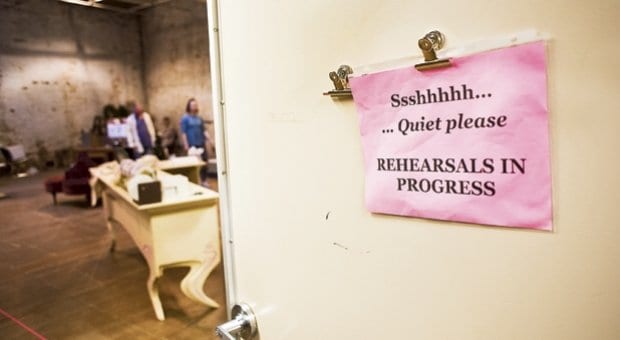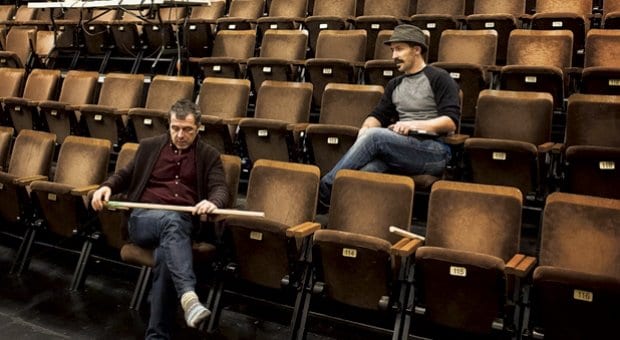
The Sandra Faire and Ivan Fecan Atrium. Credit: N Maxwell Lander

The William Hutt Library. Credit: N Maxwell Lander

A rehearsal of Parfumerie in Baillie Hall East. Credit: N Maxwell Lander
In an increasingly harsh world, where unions are deemed evil and commerce the prime indicator of success, a professional life can seem more isolated than ever. It’s dog eat dog, where you’re only as valuable as your last success. Life in the theatre is no exception, sometimes embracing the worst of these tendencies, with actors vying for the best roles, playwrights fighting for artistic freedom and companies struggling to put bums in their seats.
It makes Soulpepper all the more valuable, all the more special, as it bucks trends to create and maintain a theatre company that is both artistically responsible and materially successful.
“It’s a company in the true sense of the word,” says Paolo Santalucia, graduate of Soulpepper’s renowned training program and member of its acting troupe. “It sounds silly to say, but it really is an amazing family. We care a lot about each other, and Leslie and Albert are true community builders.”
Albert, of course, is the famous Mr Schultz, one of Canada’s most celebrated stage and film actors and founding artistic director of Soulpepper. Leslie Lester has been managing director of the Young Centre for the Performing Arts, a comprehensive arts complex located in Toronto’s historic Distillery District, since 2005.
The complex is quite remarkable. Designed by architect Thomas Payne for KPMB, the 55,000-square-foot space has both a heritage feel and a modern sensibility: two former tank houses are bridged by a magnificent glass atrium to house the company’s training, rehearsal and performance facilities. The result of a special partnership with George Brown College, it’s the perfect home for a company with such a diverse mandate.
“Soulpepper and George Brown got together in 2003 to develop a joint venture because we were interested in sharing a facility to house the theatre school and the theatre company,” Lester says. “We created a not-for-profit corporation and went into a very aggressive campaign to raise the money to build the facility.”
For Lester, who has spent most of her career in the theatre world, the resulting facility represents the culmination of both artistic achievement and community outreach.
“I’ve been with the company now for 13 years,” she says. “I didn’t know a lot about Soulpepper until then. The mentorship has always been woven into the fabric of everything we do.
“The reason why I think it’s very organic and entrenched in the company is because it was founded by artists. They already had careers, successful careers, and because they incorporated mentorship and training into the original mandate, they started giving back from day one.”
For actors like Santalucia, this direct hand in shaping a career in theatre has been invaluable, particularly given the often cruel nature of his chosen profession.
“The goal here is to be the best actors you can be,” he says. “Never in a million years did I think that there would be a place that was so accommodating and fostering to my career.
“I got a bad review the first show I did there. Somehow, I forgot that part happens because it was so exciting to be doing my first big show. But I had so much support there, with the artists around me supporting me and saying that everyone gets a bad review sometimes and that it’s not the end of the world. Yes, they’re interested in creating the best work possible, but they’re also invested in helping us to do the same.”
The company’s mandate includes creating opportunities for artists like Santalucia to take the support they receive and pay it forward to other budding artists.
“My focus has primarily been just performing with them, but I have done a lot of mentorship as well,” Santalucia says. “You get paired with a younger person who is interested in the theatre community, some of whom come in the summertime with the Soulpepper Youth Group. Then twice a month, some of us also do stories with special-needs kids.
“That’s the amazing thing about Soulpepper and the Young Centre. It’s theatre-focused, but it’s also about outreach, storytelling and community enrichment.”
soulpepper.ca

 Why you can trust Xtra
Why you can trust Xtra


